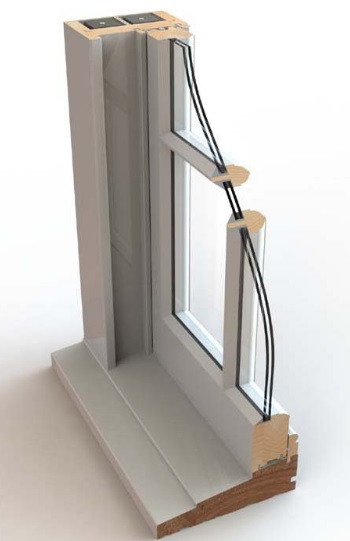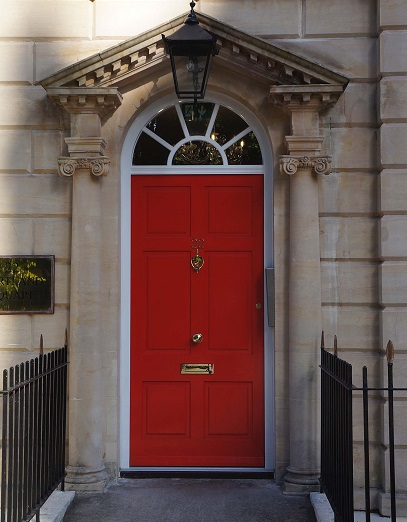Classic range by Mumford & Wood
In May 2016, Mumford & Wood announced the addition of a new timber window and door range designed especially for replacement projects in period buildings, which runs alongside the established Conservation™ range.
The appeal of the Classic™ range lies in the fact that visually it is in keeping with the period aesthetics, an important requirement for window replacement and upgrade in heritage projects and those in conservation areas where planning restrictions may apply. In part, this is achieved by having an alternative slim panel glazing system that effectively reduces sight lines and reflection.
The Classic™ range is made-to-order, available with a choice of profiles. The double glazed products feature individual 12-14 mm slim profile units with true bars and a traditional external putty-faced finish. In addition to standard annealed float glass, there is the opportunity to achieve the authentic natural appearance of hand-blown glass, with reduced reflection, by choosing either Victorian sheet or Crown glass.
These high performance windows and doors feature Krypton gas-filled panels that achieve a 1.9 W/m²K overall frame U-value, and a 1.5 W/m²K centre pane U-value, with a five-year warranty on the double glazed unit.
Along with Mumford & Wood’s other products, the Classic™ range is made from FSC-certificated Siberian Larch. This is a slow-growing and dense timber which is engineered for maximum strength and robustness.
Independent research identifies that these windows, which are made to the standards of the British Woodworking Federation Wood Window Alliance scheme, have a life cycle expectancy of up to 65 years and more.
According to Mumford & Wood, ‘our slim pane Classic will meet the aesthetic requirements of conservation and planning officers while at the same time improving the thermal, acoustic and sustainability performance of some of Britain’s most loved buildings.’
The Classic™ range includes the following products:
- Box sash windows.
- Spring sash windows.
- Tilt and slide sash windows.
- Casement windows.
- French casement windows.
- French and single doors.
- Balcony doors.
- Bi-folding doors.
- Entrance doors.
For more information, see Mumford & Wood - Classic range
Follow Mumford & Wood on Twitter
Follow Mumford & Wood on Facebook
[edit] Find out more
[edit] Related articles on Designing Buildings Wiki
Featured articles and news
One of the most impressive Victorian architects. Book review.
RTPI leader to become new CIOB Chief Executive Officer
Dr Victoria Hills MRTPI, FICE to take over after Caroline Gumble’s departure.
Social and affordable housing, a long term plan for delivery
The “Delivering a Decade of Renewal for Social and Affordable Housing” strategy sets out future path.
A change to adoptive architecture
Effects of global weather warming on architectural detailing, material choice and human interaction.
The proposed publicly owned and backed subsidiary of Homes England, to facilitate new homes.
How big is the problem and what can we do to mitigate the effects?
Overheating guidance and tools for building designers
A number of cool guides to help with the heat.
The UK's Modern Industrial Strategy: A 10 year plan
Previous consultation criticism, current key elements and general support with some persisting reservations.
Building Safety Regulator reforms
New roles, new staff and a new fast track service pave the way for a single construction regulator.
Architectural Technologist CPDs and Communications
CIAT CPD… and how you can do it!
Cooling centres and cool spaces
Managing extreme heat in cities by directing the public to places for heat stress relief and water sources.
Winter gardens: A brief history and warm variations
Extending the season with glass in different forms and terms.
Restoring Great Yarmouth's Winter Gardens
Transforming one of the least sustainable constructions imaginable.
Construction Skills Mission Board launch sector drive
Newly formed government and industry collaboration set strategy for recruiting an additional 100,000 construction workers a year.
New Architects Code comes into effect in September 2025
ARB Architects Code of Conduct and Practice available with ongoing consultation regarding guidance.
Welsh Skills Body (Medr) launches ambitious plan
The new skills body brings together funding and regulation of tertiary education and research for the devolved nation.
Paul Gandy FCIOB announced as next CIOB President
Former Tilbury Douglas CEO takes helm.


























